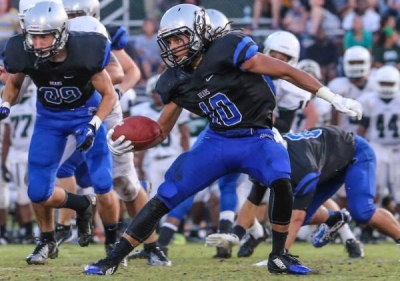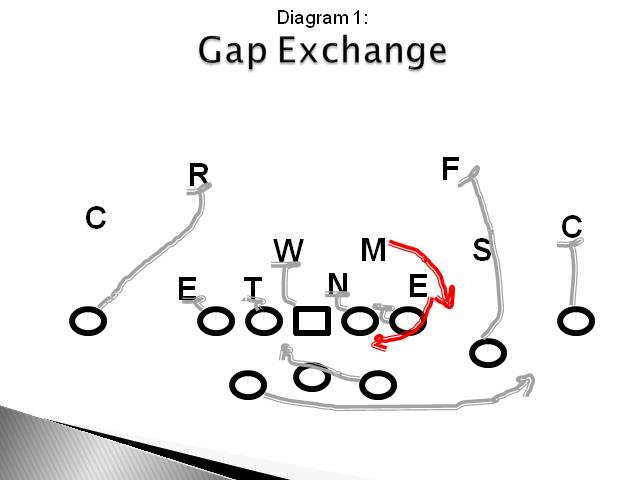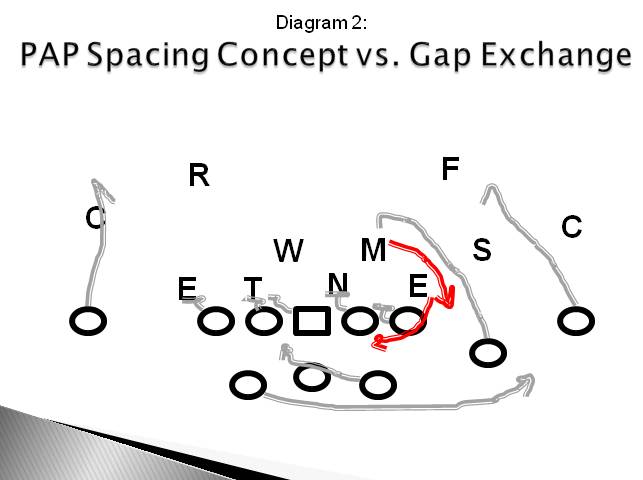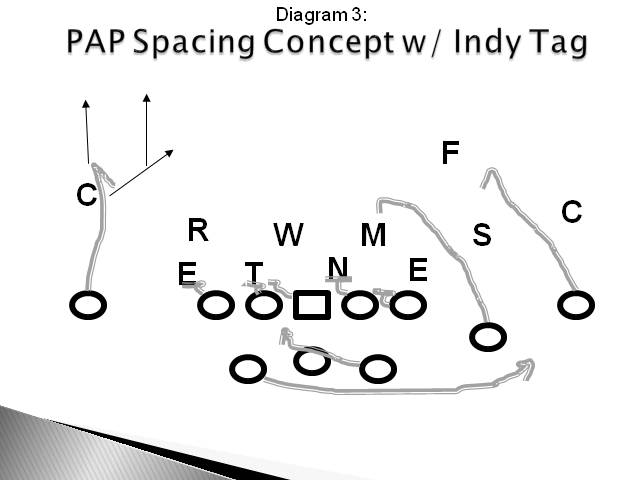By Darrell Sutherland
Head Coach
Bartram Trail High School (FL)
Introduction:
 The Triple Option is known for making defenses play “assignment” football. Play action success within a triple options offense is based on the advantage of knowing the defensive assignments. Most perimeter defenders assigned to primary or secondary run support are placed in a run/pass bind; this conflicted position leaves them vulnerable to play-action passes.
The Triple Option is known for making defenses play “assignment” football. Play action success within a triple options offense is based on the advantage of knowing the defensive assignments. Most perimeter defenders assigned to primary or secondary run support are placed in a run/pass bind; this conflicted position leaves them vulnerable to play-action passes.
The result has been increased efficiency for all of our concepts. This past year, our Inside Zone Triple (with a variety of blocking tags) was 70% efficient (4+ yards or gained a 1st down) and averaged over 6 yards an attempt. The 3-step play-action passing concepts, like Spacing and Stick shown below, were 65% efficient (7+ yards or gained us a 1st down). Lastly, the 5-step play-action concepts were 42% efficient (10+ yards or gained us a 1st down) and accounted for a number of our explosive plays, averaging 27 yards a completion.
Play-Action Basics
In our system, the Play-Action Pass serves the same function as manipulating the Option portion of the play or running Counters and gadgets. That is that they are all ways to protect our base play. It’s like life: our actions should reflect what we truly value. As the old adage goes, “show me your day timer and your checkbook, and I’ll show you what you value.” The Triple Option is what we want to be great at, so most of our practice play, much like a day timer, should reflect that. With the larger percentage of our daily practice routine dedicated to perfecting the Option, we must be very efficient with our complement plays. We can’t afford those “expensive” plays that eat up practice reps and don’t get results or even get called in games.
To economize reps, we use our existing 3 and 5 step concepts as the patterns we incorporate in our Play-Action Passes. This is an easy way to practice two things at once, and allow our players to play fast in concepts in which they are already confident.
Spacing Concept
A Horizontal Stretch, like the Spacing concept, is one way to take advantage of the voided underneath zones created by primary run support defenders aggressively attacking their assignments. Many defenses employ a Gap Exchange scheme or some other means of trying to dictate to the offense who will carry the ball (diagram 1). This can potentially compromise the flat defender and the ILB assigned to scrape outside to the QB.

By selling the Inside Zone up front and flash faking to the RB crossing the QB’s face, the offense can influence the defensive end to scrape hard, the zone side linebacker (danger player) to stay zone side, and the triple side linebacker (movement key) to step out. One of the great things about the Triple Option Play-Action Passing concepts is that the QB can read his movement key while meshing with the RB. Our Spacing concept (diagram 2) takes advantage of defenses attempting to add LBs to the option side. It also provides an easy way to tag the backside receiver to counteract when defenses drop the safety into the box to fill for the sliding linebackers (diagram 3).


Here are a few coaching points for running the Spacing concept:
#1 Receiver Play Side – Run a Slice route. Take an inside stem, climb to 8-10 yards behind the flat defender (1st underneath defender), and settle in the open space voided by the flat defender covering the Bubble route.
#2 Receiver Play Side – Run an Over-the-Ball (OTB) Route. Take an inside release on the 2nd underneath defender, climb to 6 yards, and present your front numbers to QB. If the 3rd underneath defender is over the ball, post him up play side (level with, not in front of) so your play side shoulder is “open”.
Back Side Back – Run the option track into a Bubble route. Open and crossover with your chin on your shoulder then drive for width to replace the #1 receiver’s original alignment.
#1 Receiver Back Side – Run the backside Hitch. This is a 6 yard Hitch route with 3 big steps and two little steps (3 big, 2 little). He will convert this route to a fade against press coverage or a hole route against cover 2.
Quarterback Pre Snap Read – Check backside window for a gift hitch. Take it right away if it is there.
Quarterback Post Snap Read – Read the concept from the inside out. The 2nd underneath defender is 1st movement key. Here is how we want him to respond to different movements by the movement key:
Protection – To keep things simple, we use the same Will Slide protection as we use in our drop back pro, but with “low hats”. The RB will flash fake, crossing the QBs face, and block from #1 to #2 to check down. The backside tackle is man, the back side guard is man if he is covered. If he is uncovered he starts the slide to the zone side.
Stick Concept
Another benefit of incorporating your existing 3 and 5 step concepts into your Play-Action Pass is the fact that the play has validity even if the defense doesn’t “bite” on the run fake. The Stick concept (diagram 4), is one of our most efficient 3 step concepts, and by also tying it to one of our base runs, we can call it even more often. As a “reaction” play, it is a great way to expand the sideline hole because the corner is now a primary run support defender.

Head Coach
Bartram Trail High School (FL)
Introduction:
 The Triple Option is known for making defenses play “assignment” football. Play action success within a triple options offense is based on the advantage of knowing the defensive assignments. Most perimeter defenders assigned to primary or secondary run support are placed in a run/pass bind; this conflicted position leaves them vulnerable to play-action passes.
The Triple Option is known for making defenses play “assignment” football. Play action success within a triple options offense is based on the advantage of knowing the defensive assignments. Most perimeter defenders assigned to primary or secondary run support are placed in a run/pass bind; this conflicted position leaves them vulnerable to play-action passes. The result has been increased efficiency for all of our concepts. This past year, our Inside Zone Triple (with a variety of blocking tags) was 70% efficient (4+ yards or gained a 1st down) and averaged over 6 yards an attempt. The 3-step play-action passing concepts, like Spacing and Stick shown below, were 65% efficient (7+ yards or gained us a 1st down). Lastly, the 5-step play-action concepts were 42% efficient (10+ yards or gained us a 1st down) and accounted for a number of our explosive plays, averaging 27 yards a completion.
Play-Action Basics
In our system, the Play-Action Pass serves the same function as manipulating the Option portion of the play or running Counters and gadgets. That is that they are all ways to protect our base play. It’s like life: our actions should reflect what we truly value. As the old adage goes, “show me your day timer and your checkbook, and I’ll show you what you value.” The Triple Option is what we want to be great at, so most of our practice play, much like a day timer, should reflect that. With the larger percentage of our daily practice routine dedicated to perfecting the Option, we must be very efficient with our complement plays. We can’t afford those “expensive” plays that eat up practice reps and don’t get results or even get called in games.
To economize reps, we use our existing 3 and 5 step concepts as the patterns we incorporate in our Play-Action Passes. This is an easy way to practice two things at once, and allow our players to play fast in concepts in which they are already confident.
Spacing Concept
A Horizontal Stretch, like the Spacing concept, is one way to take advantage of the voided underneath zones created by primary run support defenders aggressively attacking their assignments. Many defenses employ a Gap Exchange scheme or some other means of trying to dictate to the offense who will carry the ball (diagram 1). This can potentially compromise the flat defender and the ILB assigned to scrape outside to the QB.

By selling the Inside Zone up front and flash faking to the RB crossing the QB’s face, the offense can influence the defensive end to scrape hard, the zone side linebacker (danger player) to stay zone side, and the triple side linebacker (movement key) to step out. One of the great things about the Triple Option Play-Action Passing concepts is that the QB can read his movement key while meshing with the RB. Our Spacing concept (diagram 2) takes advantage of defenses attempting to add LBs to the option side. It also provides an easy way to tag the backside receiver to counteract when defenses drop the safety into the box to fill for the sliding linebackers (diagram 3).


Here are a few coaching points for running the Spacing concept:
#1 Receiver Play Side – Run a Slice route. Take an inside stem, climb to 8-10 yards behind the flat defender (1st underneath defender), and settle in the open space voided by the flat defender covering the Bubble route.
#2 Receiver Play Side – Run an Over-the-Ball (OTB) Route. Take an inside release on the 2nd underneath defender, climb to 6 yards, and present your front numbers to QB. If the 3rd underneath defender is over the ball, post him up play side (level with, not in front of) so your play side shoulder is “open”.
Back Side Back – Run the option track into a Bubble route. Open and crossover with your chin on your shoulder then drive for width to replace the #1 receiver’s original alignment.
#1 Receiver Back Side – Run the backside Hitch. This is a 6 yard Hitch route with 3 big steps and two little steps (3 big, 2 little). He will convert this route to a fade against press coverage or a hole route against cover 2.
Quarterback Pre Snap Read – Check backside window for a gift hitch. Take it right away if it is there.
Quarterback Post Snap Read – Read the concept from the inside out. The 2nd underneath defender is 1st movement key. Here is how we want him to respond to different movements by the movement key:
- In the case of a blitz, the QB will throw the ball right now to the slot player.
- If the key widens, hit the slot who is now posting up 3rd defender.
- If he brackets the slot, he needs to reset his feet and read the flat defender (1st underneath player) for a high low with the bubble and slice routes.
Protection – To keep things simple, we use the same Will Slide protection as we use in our drop back pro, but with “low hats”. The RB will flash fake, crossing the QBs face, and block from #1 to #2 to check down. The backside tackle is man, the back side guard is man if he is covered. If he is uncovered he starts the slide to the zone side.
Stick Concept
Another benefit of incorporating your existing 3 and 5 step concepts into your Play-Action Pass is the fact that the play has validity even if the defense doesn’t “bite” on the run fake. The Stick concept (diagram 4), is one of our most efficient 3 step concepts, and by also tying it to one of our base runs, we can call it even more often. As a “reaction” play, it is a great way to expand the sideline hole because the corner is now a primary run support defender.










